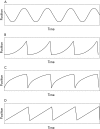Motor and sensory characteristics of infantile nystagmus
- PMID: 12234898
- PMCID: PMC1771304
- DOI: 10.1136/bjo.86.10.1152
Motor and sensory characteristics of infantile nystagmus
Abstract
Background/aims: Past studies have explored some of the associations between particular motor and sensory characteristics and specific categories of non-neurological infantile nystagmus. The purpose of this case study is to extend this body of work significantly by describing the trends and associations found in a database of 224 subjects who have undergone extensive clinical and psychophysical evaluations.
Methods: The records of 224 subjects with infantile nystagmus were examined, where 62% were idiopaths, 28% albinos, and 10% exhibited ocular anomalies. Recorded variables included age, mode of inheritance, birth history, nystagmus presentation, direction of the nystagmus, waveform types, spatial and temporal null zones, head postures and nodding, convergence, foveation, ocular alignment, refractive error, visual acuity, stereoacuity, and oscillopsia.
Results: The age distribution of the 224 patients was between 1 month and 71 years, with the mean age and mode being 23 (SD 16) years and 16-20 years respectively. By far the most common pattern of inheritance was found to be autosomal dominant (n = 40), with the nystagmus being observed by the age of 6 months in 87% of the sample (n = 128). 139 (62%) of the 224 subjects were classified as idiopaths, 63 (28%) as albinos, and 22 (10%) exhibited ocular anomalies. Conjugate uniplanar horizontal oscillations were found in 174 (77.7%) of the sample. 32 (14.3%) had a torsional component to their nystagmus. 182 (81.2%) were classed as congenital nystagmus (CN), 32 (14.3%) as manifest latent nystagmus (MLN), and 10 (4.5%) as a CN/MLN hybrid. Neither CN nor MLN waveforms were related to any of the three subject groups (idiopaths, albinos, and ocular anomalies) MLN was found in idiopaths and albinos, but most frequently in the ocular anomaly group. The most common oscillation was a horizontal jerk with extended foveation (n = 49; 27%). The amplitudes and frequencies of the nystagmus ranged between 0.3-15.7 degrees and 0.5-8 Hz, respectively. Periodic alternating nystagmus is commonly found in albinos. Albino subjects did not show a statistically significantly higher nystagmus intensity when compared with the idiopaths (p>0.01). 105 of 143 subjects (73%) had spatial nulls within plus or minus 10 degrees of the primary position although 98 subjects (69%) employed a compensatory head posture. Subjects with spatial null zones at or beyond plus or minus 20 degrees always adopted constant head postures. Head nodding was found in 38 subjects (27% of the sample). Horizontal tropias were very common (133 out of 213; 62.4%) and all but one of the 32 subjects with MLN exhibited a squint. Adult visual acuity is strongly related to the duration and accuracy of the foveation period. Visual acuity and stereoacuity were significantly better (p<0.01) in the idiopaths compared to the albino and ocular anomaly groups. 66 subjects out of a sample of 168 (39%) indicated that they had experienced oscillopsia at some time.
Conclusions: There are strong ocular motor and sensory patterns and associations that can help define an infantile nystagmus. These include the nystagmus being bilateral, conjugate, horizontal uniplanar, and having an accelerating slow phase (that is, CN). Decelerating slow phases (that is, MLN) are frequently associated with strabismus and early form deprivation. Waveform shape (CN or MLN) is not pathognomonic of any of the three subject groups (idiopaths, albinos, or ocular anomalies). There is no one single stand alone ocular motor characteristic that can differentiate a benign form of infantile nystagmus (CN, MLN) from a neurological one. Rather, the clinician must consider a host of clinical features.
Figures









Similar articles
-
Clinical and oculomotor characteristics of albinism compared to FRMD7 associated infantile nystagmus.Invest Ophthalmol Vis Sci. 2011 Apr 8;52(5):2306-13. doi: 10.1167/iovs.10-5685. Invest Ophthalmol Vis Sci. 2011. PMID: 21220551
-
Two types of foveation strategy in 'latent' nystagmus: fixation, visual acuity and stability.Neuroophthalmology. 1995 Aug;15(4):167-86. doi: 10.3109/01658109509044600. Neuroophthalmology. 1995. PMID: 11542501
-
Periodic alternating nystagmus in humans with albinism.Invest Ophthalmol Vis Sci. 1994 Nov;35(12):4080-6. Invest Ophthalmol Vis Sci. 1994. PMID: 7960590
-
Nystagmus in childhood.Pediatr Neonatol. 2014 Oct;55(5):341-51. doi: 10.1016/j.pedneo.2014.02.007. Epub 2014 Jul 31. Pediatr Neonatol. 2014. PMID: 25086850 Review.
-
The diagnosis and treatment of infantile nystagmus syndrome (INS).ScientificWorldJournal. 2006 Oct 30;6:1385-97. doi: 10.1100/tsw.2006.248. ScientificWorldJournal. 2006. PMID: 17086344 Free PMC article. Review.
Cited by
-
Evaluation of the Nystagmus Information Pack.Br Ir Orthopt J. 2022 Sep 15;18(1):111-120. doi: 10.22599/bioj.269. eCollection 2022. Br Ir Orthopt J. 2022. PMID: 36186145 Free PMC article.
-
Eye muscle surgery for infantile nystagmus syndrome in the first two years of life.Clin Ophthalmol. 2009;3:615-24. doi: 10.2147/opth.s7541. Epub 2009 Nov 16. Clin Ophthalmol. 2009. PMID: 19997564 Free PMC article.
-
Five novel mutations of the FRMD7 gene in Chinese families with X-linked infantile nystagmus.Mol Vis. 2008 Apr 18;14:733-8. Mol Vis. 2008. PMID: 18431453 Free PMC article.
-
Reliability and Validity of Gaze-Dependent Functional Vision Space: A Novel Metric Quantifying Visual Function in Infantile Nystagmus Syndrome.Invest Ophthalmol Vis Sci. 2018 Apr 1;59(5):1760-1768. doi: 10.1167/iovs.17-23229. Invest Ophthalmol Vis Sci. 2018. PMID: 29610862 Free PMC article.
-
Velocity Discrimination in Infantile Nystagmus Syndrome.Invest Ophthalmol Vis Sci. 2021 Aug 2;62(10):35. doi: 10.1167/iovs.62.10.35. Invest Ophthalmol Vis Sci. 2021. PMID: 34459850 Free PMC article.
References
-
- Dell’Osso LF. Congenital, latent and manifest latent nystagmus—similarities, differences and relation to strabismus. Jap J Ophthalmol 1985;29:351–68. - PubMed
-
- Harris C. Nystagmus and eye movement disorders In: Taylor D, ed. Paediatric ophthalmology. Oxford: Blackwell Science, 1997:869–95.
-
- Leigh RJ. Averbuch-Heller L. Nystagmus and related ocular motility disorders In: Miller NR, Newman NJ eds. Walsh and Hoyt’s Clinical Neuro-Ophthalmology. Vol 1, 5th ed. Baltimore: William and Wilkins, 1998:1461–505.
-
- Dell’Osso LF, Daroff RB. Nystagmus and saccadic intrusions and oscillations In: Glaser JS ed. Neuro-Ophthalmology. 3rd ed. Philadelphia: Lippincott, Williams and Wilkins, 1999:369–401.
-
- Abadi RV, Dickinson CM. Waveform characteristics in congenital nystagmus. Doc Ophthalmol 1986;64:153–67. - PubMed
MeSH terms
LinkOut - more resources
Full Text Sources
Miscellaneous
